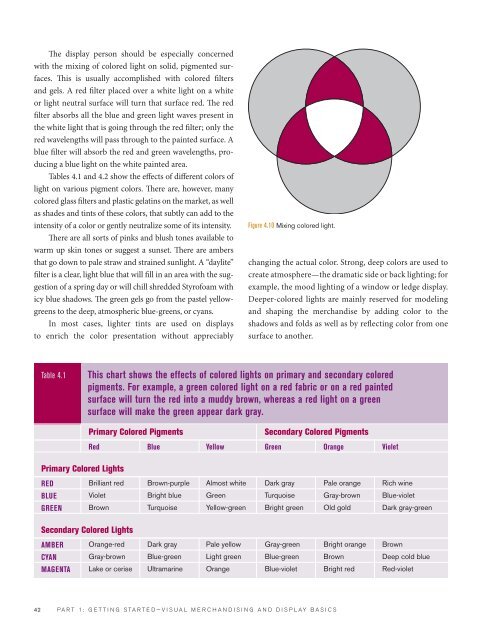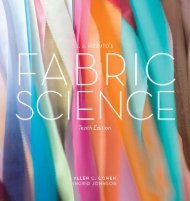Visual Merchandising Display - Fairchild Books
Visual Merchandising Display - Fairchild Books
Visual Merchandising Display - Fairchild Books
You also want an ePaper? Increase the reach of your titles
YUMPU automatically turns print PDFs into web optimized ePapers that Google loves.
The display person should be especially concerned<br />
with the mixing of colored light on solid, pigmented surfaces.<br />
This is usually accomplished with colored filters<br />
and gels. A red filter placed over a white light on a white<br />
or light neutral surface will turn that surface red. The red<br />
filter absorbs all the blue and green light waves present in<br />
the white light that is going through the red filter; only the<br />
red wavelengths will pass through to the painted surface. A<br />
blue filter will absorb the red and green wavelengths, producing<br />
a blue light on the white painted area.<br />
Tables 4.1 and 4.2 show the effects of different colors of<br />
light on various pigment colors. There are, however, many<br />
colored glass filters and plastic gelatins on the market, as well<br />
as shades and tints of these colors, that subtly can add to the<br />
intensity of a color or gently neutralize some of its intensity.<br />
There are all sorts of pinks and blush tones available to<br />
warm up skin tones or suggest a sunset. There are ambers<br />
that go down to pale straw and strained sunlight. A “daylite”<br />
filter is a clear, light blue that will fill in an area with the suggestion<br />
of a spring day or will chill shredded Styrofoam with<br />
icy blue shadows. The green gels go from the pastel yellowgreens<br />
to the deep, atmospheric blue-greens, or cyans.<br />
In most cases, lighter tints are used on displays<br />
to enrich the color presentation without appreciably<br />
42<br />
Primary Colored Lights<br />
Figure 4.10 Mixing colored light.<br />
P a r t 1 : G e t t i n G S ta r t e d — V i S u a l M e r c h a n d i S i n G a n d d i S P l ay B a S i c S<br />
changing the actual color. Strong, deep colors are used to<br />
create atmosphere—the dramatic side or back lighting; for<br />
example, the mood lighting of a window or ledge display.<br />
Deeper-colored lights are mainly reserved for modeling<br />
and shaping the merchandise by adding color to the<br />
shadows and folds as well as by reflecting color from one<br />
surface to another.<br />
Table 4.1 this chart shows the effects of colored lights on primary and secondary colored<br />
pigments. For example, a green colored light on a red fabric or on a red painted<br />
surface will turn the red into a muddy brown, whereas a red light on a green<br />
surface will make the green appear dark gray.<br />
Primary Colored Pigments Secondary Colored Pigments<br />
Red Blue Yellow Green Orange Violet<br />
Red Brilliant red Brown-purple Almost white Dark gray Pale orange Rich wine<br />
Blue Violet Bright blue Green Turquoise Gray-brown Blue-violet<br />
GReen Brown Turquoise Yellow-green Bright green Old gold Dark gray-green<br />
Secondary Colored Lights<br />
AmBeR Orange-red Dark gray Pale yellow Gray-green Bright orange Brown<br />
CYAn Gray-brown Blue-green Light green Blue-green Brown Deep cold blue<br />
mAGentA Lake or cerise Ultramarine Orange Blue-violet Bright red Red-violet













